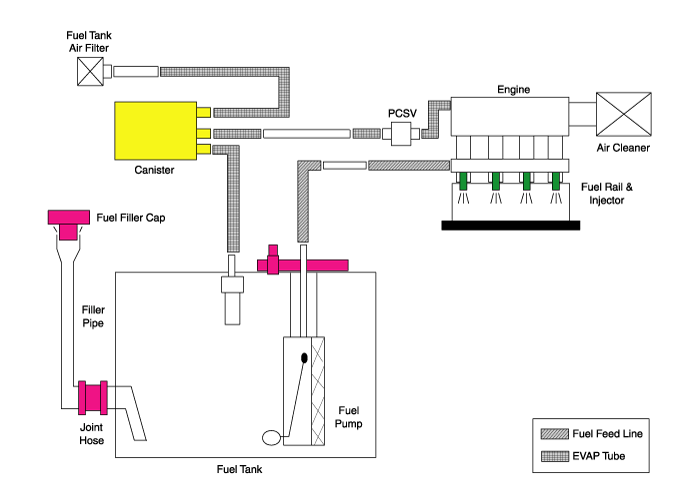Hyundai Kona: Evaporative Emission Control System / Schematic diagrams
Hyundai Kona (OS) 2018-2025 Service Manual / Emission Control System / Evaporative Emission Control System / Schematic diagrams
| Schematic Diagram |

Canister
The Canister is filled with charcoal and absorbs evaporated fuel vapor from
the fuel tank. The gathered fuel vapor in canister is drawn into the intake
manifold by the ECM/PCM when appropriate conditions are set.
Purge Control Solenoid Valve (PCSV)
The Purge Control Solenoid Valve (PCSV) is installed in the passage connecting
the canister to the intake manifold. It is a duty type solenoid valve and is
operated by ECM/PCM signal.
To draw the absorbed vapor into the intake manifold, the ECM/PCM will open the
PCSV, otherwise the passage remains closed.
Fuel Filler Cap
A ratchet tightening device in the threaded fuel filler cap reduces the chances
of incorrect installation, when sealing the fuel filler. After the gasket on
the fuel filler cap and the fill neck flange make contact, the ratchet produces
a loud clicking noise indicating the seal has been set.
 Description and operation
Description and operation
Description
The Evaporative Emission Control System prevents fuel vapor stored in fuel tank
from vaporizing into the atmosphere. When the fuel evaporates in the fuel tank,
the va ...
 Repair procedures
Repair procedures
Inspection
[System Inspection]
1.
Disconnect the vapor hose from the intake manifold and connect a vacuum
pump to the nipple on the intake manifold.
...
Other information:
Hyundai Kona (OS) 2018-2025 Service Manual: Description and operating principle
Description and Operation
Wireless Power Charger System
During ACC or IG ON, battery voltage is supplied to the wireless power charger
system to transmit an output of 5 W to mobile phone.
Mobile phones certified with the wireless charging standard WPC (Qi 1.1.2 ...
Hyundai Kona (OS) 2018-2025 Owners Manual: Cup holder
Front
Cups or small beverages cups may be placed in the cup holders.
Rear
Pull the armrest down to use the cup holders.
WARNING
Avoid abrupt starting and braking when the cup holder is in use to
prevent spilling your drink. If hot liquid spills, you could be burned. Such
a burn to the driver ...
В© 2018-2025 www.hkona.com
